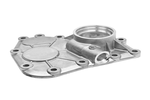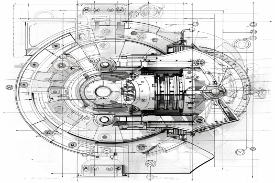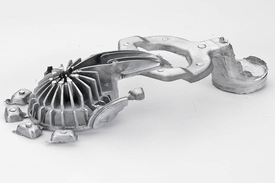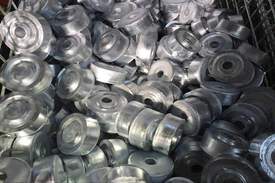Die Casting
Home > Die Casting
As a leading die casting supplier, we deliver end-to-end solutions tailored to your industrial needs. With over a decade of expertise as a premier China-based manufacturer, we balance uncompromising quality with competitive pricing—making us the reliable partner your projects deserve.
Your Trusted Partner for custom die casting
- Automotive components (engine parts, structural brackets)
- Electronic enclosures and housings
- Machinery and equipment fittings
- Architectural hardware and fixtures
- Precision parts for toys, models, and household goods
some products
Custom Die Casting for Every Venture

Die Casting Parts

Die Casting Parts

Die-Casting-Parts

Die-Casting-Parts

Die-Casting-Parts

Die Casting Parts

Custom Die Casting Needs
- Engineering Precision That Matters: Achieve tight tolerances (±0.02mm) and flawless surface finishes that eliminate post-processing delays, ensuring every component integrates seamlessly into your assembly line.
- Scalability Without Compromise: From prototype runs to high-volume production (10k–1M+ units), our optimized die casting processes maintain speed and consistency, keeping your supply chain on track.
- Material Efficiency for Performance: Leverage lightweight alloys (aluminum, zinc, magnesium) to reduce overall product weight by up to 30% while enhancing structural integrity—critical for energy efficiency and durability.
- Design Freedom Unlocked: Transform complex geometries, internal cavities, and intricate features into reality. No more design compromises—our die casting capabilities turn your most ambitious blueprints into tangible parts.
- Longevity in Every Environment: Choose from specialized coatings (e.g., powder coating, anodizing) and material grades to ensure corrosion resistance, thermal stability, and extended service life, even in harsh operating conditions.
Let’s Discuss Your Unique Die-casting Requirements
Unpacking every detail of custom die casting parts can be complex, so we’ve packed this page with in-depth resources to guide your decisions—and to help you find what you need without delay, we’ve added a clickable content directory that jumps straight to key sections, from material specs to production workflows.
General Applications For Die Casting
- Automotive Engineering: Power train components, transmission housings, and structural brackets that withstand extreme temperatures and vibration, reducing vehicle weight without sacrificing strength.
- Aerospace Systems: Lightweight alloy parts for aircraft frames, engine components, and avionics enclosures, meeting strict aerospace-grade tolerances and material certifications.
- Electronics Manufacturing: Heat-dissipating casings for servers, precision connectors, and sensor housings that protect sensitive electronics while enabling seamless assembly.
- Industrial Machinery: Heavy-duty pump housings, valve bodies, and gearbox components that resist corrosion and wear in high-pressure, high-cycle environments.
- Building & Construction: High-strength door hardware, structural fittings, and fixture components that balance aesthetics with long-term durability in commercial and residential projects.
- Renewable Energy: Custom frames for solar panels, wind turbine connectors, and battery enclosures engineered to perform in harsh outdoor conditions.
- Medical Devices: Sterilizable instrument housings, prosthetic components, and diagnostic equipment parts that meet biocompatibility standards and tight dimensional accuracy.
- Telecommunications: Weather-resistant enclosures for cell towers, router chassis, and fiber optic connectors that ensure reliable performance in critical infrastructure.
- Consumer Durables: High-end lighting fixtures, appliance components, and furniture hardware that combine visual appeal with rugged functionality.
- Recreational Products: Heavy-duty parts for outdoor equipment, marine accessories, and industrial-grade toys that stand up to rigorous use.
Main Process For Die Casting
Die casting delivers the precision and consistency your production line demands through a streamlined, controlled workflow—here’s how it ensures your parts meet exact specifications, every time:

Pre-Production Prep
- Tooling Engineering: Molds are precision-machined to your exact design specs, with tight tolerances (±0.02mm) that eliminate post-production rework. Material selection (aluminum, zinc, or magnesium alloys) aligns with your part’s functional needs—whether you require lightweight strength, corrosion resistance, or high thermal conductivity.
Metal Melting: Alloys are heated to precise temperatures in controlled furnaces, with real-time composition checks to maintain material integrity—critical for parts that need to perform under stress.

Casting Execution
- High-Pressure Injection: Molten metal is injected into molds at pressures up to 1,500 bar, ensuring complete cavity filling even for complex geometries. This speed minimizes porosity and ensures uniform density.
- Rapid Cooling: Molds are engineered for optimal heat transfer, solidifying parts quickly to lock in dimensional stability and structural strength.
- Efficient Ejection: Automated systems remove parts without damage, maintaining consistency across high-volume runs (10k–1M+ units).

Post-Processing Refinement
- Precision Finishing: Deburring, trimming, and CNC machining refine edges and critical surfaces to meet your assembly’s exact fit requirements.
- Performance Enhancement: Heat treatments boost tensile strength; surface finishes (anodizing, powder coating, plating) improve corrosion resistance or aesthetics, depending on your end-use environment.
Thorough Cleaning: Ultrasonic or chemical cleaning removes residues, ensuring parts integrate seamlessly into your production line—no contamination risks.

Quality Validation
- Dimensional Verification: Laser scanning and CMM inspections confirm every critical dimension matches your CAD specs, eliminating fit issues downstream.
- Structural Testing: Tensile, hardness, and impact tests validate mechanical performance, while leak testing ensures hermetic seals for fluid or gas applications.
- Visual Inspection: Automated optical systems detect micro-defects, ensuring only parts meeting your quality threshold move to final delivery.
Estimated Cost Analysis For Die Casting
Final pricing hinges on your custom requirements: the complexity of your design, raw material specifications (e.g., aluminum, zinc alloys), regional regulatory compliance, and shipping logistics. For context, consider a bulk order scenario:

Die casting costs break down into core components: raw material expenses, mold fabrication, equipment operation, skilled labor, energy consumption, post-processing (finishing, machining), and rigorous quality control. These variables shift based on your project’s scale, design intricacies, and current market conditions to ensure cost alignment with your needs.
$1,580
Take U.S.-bound shipments as an example: typical sea freight costs include base shipping rates, fuel surcharges, port handling fees, storage charges, and optional add-ons like cargo insurance or customs declaration services. Exact figures depend on your shipment’s weight, distance, and chosen transport mode—ensuring transparency in logistics budgeting.
$800
Customs duties vary by country and region, with potential additional fees such as VAT, consumption taxes, or anti-dumping duties applying based on local policies. These factors are integrated into your cost analysis to avoid unexpected expenses and keep your project on budget.
$500The Process Flow & Duration Estimation
Timelines adapt to your project’s unique needs, shaped by design complexity, mold fabrication, production volume, material availability, quality standards, and coordination schedules. Here’s a breakdown of key phases:
Step 1: R&D Drawings (3-7 days)
This phase hinges on design intricacy, revision feedback, process requirements, and approval workflows. Simple designs move faster; complex geometries or multiple iterations may extend timelines slightly. Our team prioritizes alignment with your specs to avoid delays in downstream stages.

Step 2: Sampling (7-14 days)
Sample turnaround depends on part complexity, size, and testing needs. Larger or more intricate components require additional processing, while equipment availability and quality checks (e.g., dimensional verification) also influence timing. We ensure samples reflect your final production standards to accelerate approval.

Step 3: Pay The Bill (within 1 day)
We align on flexible payment terms—advance deposits, milestone payments, or post-completion settlements—tailored to your cash flow needs. Finalizing this step quickly keeps your project on track.

Step 4: Bulk Manufacturing (30-45 days)
Production duration is driven by order volume, raw material readiness, and line efficiency. Complex parts or high-volume runs may require optimized scheduling, while proactive maintenance and quality checks prevent bottlenecks. We mitigate delays by monitoring supply chains and production metrics closely.

Step 5: Shipping (10-15 days)
Transport time varies by distance, mode (sea, air, land), and customs clearance. Factors like weather, port congestion, or documentation accuracy can impact timelines, but we coordinate with logistics partners to minimize disruptions and keep you updated on delivery progress.

Want to eliminate delays in your supply chain?
Looking for a reliable way to accelerate your die casting project without compromising quality? ⚡
Discover how our optimized processes keep your timeline under control while delivering precision parts.
U know every day of delay costs business. That’s why our focus is on faster production, tighter quality checks, and seamless logistics to keep U ahead of schedule.
Here’s what U gain:
30% faster lead times: Streamlined workflows and automation that beat industry averages.
Custom-fit solutions: Complex geometries? No problem—our experts adapt to your exact needs.
No blind spots in communication: U get real-time updates from design to final delivery.
💬 Leave your details today—our team will contact U within 24 hours to discuss how to fast-track your project.
We respect your privacy. Your information remains 100% confidential.
The Basic Knowledge About Die Casting
Die casting is a high-precision manufacturing process built for efficient production of complex metal parts at scale.
The Common Pitfalls About Die Casting
In custom die casting, navigating potential pitfalls is critical to protecting your project’s quality, timeline, and budget. These hidden risks can derail even well-planned orders—here’s what to watch for and how to guard against them:
- Low Price Lures
- Quality Shortfalls
- Mismatched Technical Specs
- Delivery Delays
- Inadequate After-Sales Support
- Intellectual Property Risks
Why Choose Jiaen MFG for Your Die Casting Needs
As a trusted leader in die casting for industrial machinery, Jiaen MFG delivers high-quality, custom metal components tailored to your unique requirements. Our parts power critical applications across automotive, aerospace, electronics, and telecommunications—backed by end-to-end solutions that streamline your supply chain. Partner with us to strengthen your product’s performance and gain a competitive edge in the market.

- Industry-Recognized Certifications: Our processes meet global quality standards, ensuring compliance with automotive, aerospace, and electronics regulations.
- Rigorous Quality Control: From material testing to final inspection, every part undergoes strict checks to guarantee precision, durability, and consistency.
- Versatile Surface Finishes: We offer a range of treatments—anodizing, plating, powder coating—to enhance corrosion resistance, aesthetics, and functionality.
- Confidentiality Guaranteed: We sign NDAs to protect your designs, ensuring your intellectual property remains secure throughout the partnership.
The FAQs About Die Casting
Welcome to our Frequently Asked Questions page for die casting buyers. Here, we address the common questions you may have to help you navigate your custom die casting projects with confidence. We’re committed to clarity and support, ensuring you have the insights needed to make informed decisions about your parts and services.
What materials are most commonly used in die casting, and how do I choose the right one?
The most popular die casting materials are aluminum, zinc, and magnesium alloys. Aluminum offers a balance of strength, lightweight properties, and corrosion resistance—ideal for automotive and electronics. Zinc provides high precision and excellent surface finishes, suited for small components like hardware. Magnesium is the lightest option, perfect for weight-critical applications like aerospace. Choose based on your part’s functional needs: strength, weight, cost, and environmental conditions.
What’s the minimum order quantity (MOQ) for custom die casting projects?
MOQs vary by project complexity and mold costs, but typical ranges start at 10,000 units for standard parts. This is because initial tooling investment is spread across production runs, making larger orders more cost-effective. For prototypes or low-volume needs, we offer flexible solutions like rapid tooling, though per-unit costs may be higher.
How long does it take to develop a custom die casting mold and start production?
Mold development typically takes 4–6 weeks for standard designs, depending on complexity (e.g., intricate geometries or tight tolerances may extend timelines). Once molds are approved, production can start within 1–2 weeks for samples, with bulk manufacturing following in 30–45 days. We provide a detailed timeline upfront to align with your project deadlines.
What quality standards do you follow, and how are parts inspected?
We adhere to ISO 9001 and industry-specific standards (e.g., IATF 16949 for automotive). Parts undergo multi-stage inspections: dimensional checks via CMM (Coordinate Measuring Machines), surface defect scans, material certification verification, and functional testing (e.g., pressure or load tests). We share inspection reports with you to confirm compliance before shipment.
Can you handle post-processing like machining or surface finishes?
Yes—we offer end-to-end post-processing, including CNC machining for tight-tolerance features, anodizing for corrosion resistance, powder coating for aesthetics, and plating (e.g., chrome or nickel) for durability. These services are integrated into production to streamline your supply chain and ensure consistency.
How do you manage intellectual property (IP) for custom designs?
Your IP is protected through strict confidentiality agreements (NDAs) signed before project initiation. We limit access to design files to authorized team members only and do not reuse or share your molds or specifications without explicit permission. All tooling remains your property unless stated otherwise in the contract.
What factors affect die casting costs, and how can I optimize my budget?
Cost drivers include material type, mold complexity, order volume, and post-processing needs. To optimize budgets: choose standard alloys where possible, design for manufacturability (simplify geometries), and commit to larger volumes to lower per-unit costs. Our engineers can review your design for cost-saving opportunities without compromising quality.
What happens if parts don’t meet our specifications upon delivery?
We stand behind our quality—if parts fail to meet agreed standards, we conduct a root-cause analysis within 48 hours. Remedies may include rework, replacement, or cost adjustments, as outlined in our quality assurance agreement. Our goal is to resolve issues quickly to minimize disruption to your production schedule.














